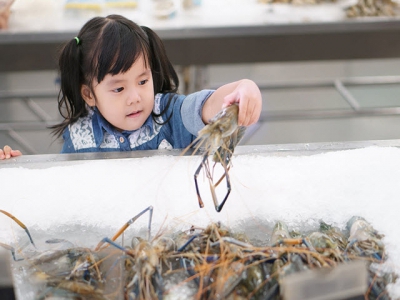How we can help children reach for seafood

Educate the next generation of consumers about healthier eating and lifestyles
Protein and Vitamin B12 in shrimp help tissue and structural development, and the omega-3 fatty acids in shrimp help infants and toddlers develop better brains, eyes and bones. Shutterstock image.
When we talk about seafood and how to increase seafood consumption to maintain and improve our health, we often neglect children, a most important segment of the population. According to the World Health Organization (WHO), young children should consume a variety of foods, including meat, poultry, fish or eggs.
The WHO also reports that eating seafood at an early age can help develop good eating habits later in life. Its dietary guidelines state that children should eat two seafood servings every week in age-appropriate portions to match their caloric requirements.
However, many children around the world, including in developed countries, are likely not consuming enough seafood and are missing out on its many and important health benefits, including those that support their physical and mental development. In the United States, for example, younger age and lower income and education levels were associated with lower odds of being a seafood consumer in a study by the National Health and Nutrition Examination Surveys.
The percentage of U.S. children with obesity has more than tripled since the 1970s, with about one in five school-aged children (ages 6 to 19) considered obese. Responsible parents can help their children learn and have a healthy life by feeding them healthy food – like seafood – as early as possible.
Seafood benefits for children
Seafood is a great source of protein, which helps the body repair and make new cells. This is especially important during childhood and adolescence, when a child is growing fast.
Compared to other animal protein sources like eggs, chicken, turkey and low-fat cheese, seafood has relatively high levels of protein, which improves energy levels and supports muscle tissue restoration. And adequate protein intake helps adults and children alike produce antibodies to help us battle a number of serious diseases (Perelman School of Medicine at the University of Pennsylvania, “Protein serves as natural boost for immune system’s fight against infection, tumors,” ScienceDaily, 30 January 2014).
To grow and develop properly, young ones must have a diet rich in vitamins, while at the same time they require less energy than adults. That is where seafood – with a high nutrient density and manageable calorie content – is particularly important for the well-being of growing kids. According to the U.S. Center for Disease Control, at least half of children worldwide ages 6 months to 5 years suffer from one or more vitamin and other micronutrient deficiencies, and globally more than 2 billion people are affected.
A 2006 Harvard School of Public Health study concluded that diets high in fatty fish supported important brain and neurological development in children, citing the importance of the omega-3 fatty acids (EPA and DHA) it provides.
Seafood’s high omega-3 fatty acid content is very important as building blocks of cell membranes, which are the component of the cell that communicates with the environment and sends signals back to the cells. And a diet rich in omega-3 fatty acids supports the development of a strong and responsive immune system.
For unborn babies, DHA consumption during pregnancy can improve a child’s IQ by age 4. For newborns to 6 months, benefits include better hand-eye coordination at 2 years compared with babies who didn’t get enough DHA. From 6 months to 2 years, DHA stimulates the production of a hormone that is vital for brain development during this critical time of rapid growth
And for kids 2 to 5 years, low levels of DHA have been linked to an increased risk of ADHD, vision problems and depression.
What about shrimp?
Consuming shrimp has numerous benefits for children’s growth and development Shrimp have high levels of several critical minerals, including zinc, phosphorus, calcium and iodine that are essential for the mental and physical development of a child. Significant levels of protein and Vitamin B12 in shrimp helps tissue and structural development, and the omega-3 fatty acids in shrimp help infants and toddlers develop better brains, eyes and bones.
Vitamin D helps the body absorb calcium and other minerals and builds strong teeth and bones. It also prevents children from suffering from rickets and supports reaching a child’s true height and maximum bone mass. Shrimp is a rich source of iron and helps support the high energy levels of growing children; its Vitamin A content supports vision development and provides protection against infections, and together with other vitamins and minerals, can help maintain adequate body weights.
As with other foods, it is always advisable to consult with their physician or health provider before young children start eating shrimp, as there are always some important considerations including potential shrimp or shellfish allergies.
It is vital to educate both the children and the parents on the benefits of intelligent consumption of seafood, and how to make smart and consequential choices. Helping educate the next generations of consumers to a healthier eating lifestyle must be an important priority for everyone in the seafood business.
Related news
Tools

Phối trộn thức ăn chăn nuôi

Pha dung dịch thủy canh

Định mức cho tôm ăn

Phối trộn phân bón NPK

Xác định tỷ lệ tôm sống

Chuyển đổi đơn vị phân bón

Xác định công suất sục khí

Chuyển đổi đơn vị tôm

Tính diện tích nhà kính

Tính thể tích ao



 Demand for VN seafood on the rise
Demand for VN seafood on the rise  Pangasius farmers get some profit to work with…
Pangasius farmers get some profit to work with…